warning YAMAHA JOG50R 2014 Owners Manual
[x] Cancel search | Manufacturer: YAMAHA, Model Year: 2014, Model line: JOG50R, Model: YAMAHA JOG50R 2014Pages: 76, PDF Size: 1.51 MB
Page 3 of 76
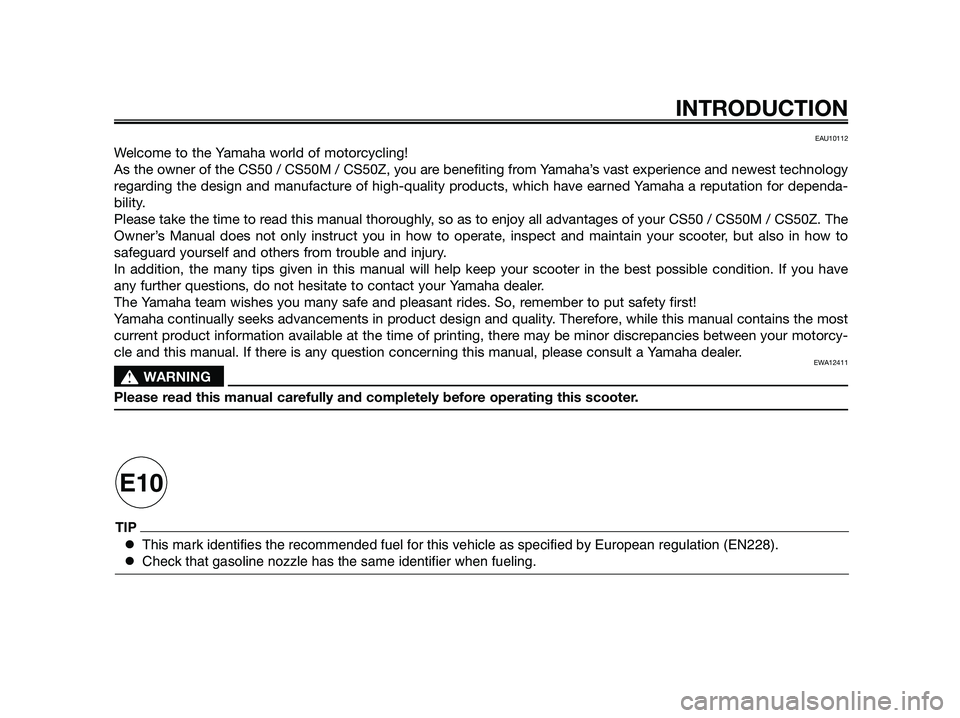
EAU10112
Welcome to the Yamaha world of motorcycling!
As the owner of the CS50 / CS50M / CS50Z, you are benefiting from Yamaha’s vast experience and newest technology
regarding the design and manufacture of high-quality products, which have earned Yamaha a reputation for dependa-
bility.
Please take the time to read this manual thoroughly, so as to enjoy all advantages of your CS50 / CS50M / CS50Z. The
Owner’s Manual does not only instruct you in how to operate, inspect and maint\
ain your scooter, but also in how to
safeguard yourself and others from trouble and injury.
In addition, the many tips given in this manual will help keep your scoo\
ter in the best possible condition. If you have
any further questions, do not hesitate to contact your Yamaha dealer.
The Yamaha team wishes you many safe and pleasant rides. So, remember to put safety first!
Yamaha continually seeks advancements in product design and quality. Therefore, while this manual contains the most
current product information available at the time of printing, there may be minor discrepancies between your motorcy-
cle and this manual. If there is any question concerning this manual, please consult a Yamaha dealer.
EWA12411
sWARNING
Please read this manual carefully and completely before operating this scooter.
INTRODUCTION
This mark identifies the recommended fuel for this vehicle as specified \
by European regulation (EN228).
Check that gasoline nozzle has the same identifier when fueling.
TIP
E10
Page 4 of 76
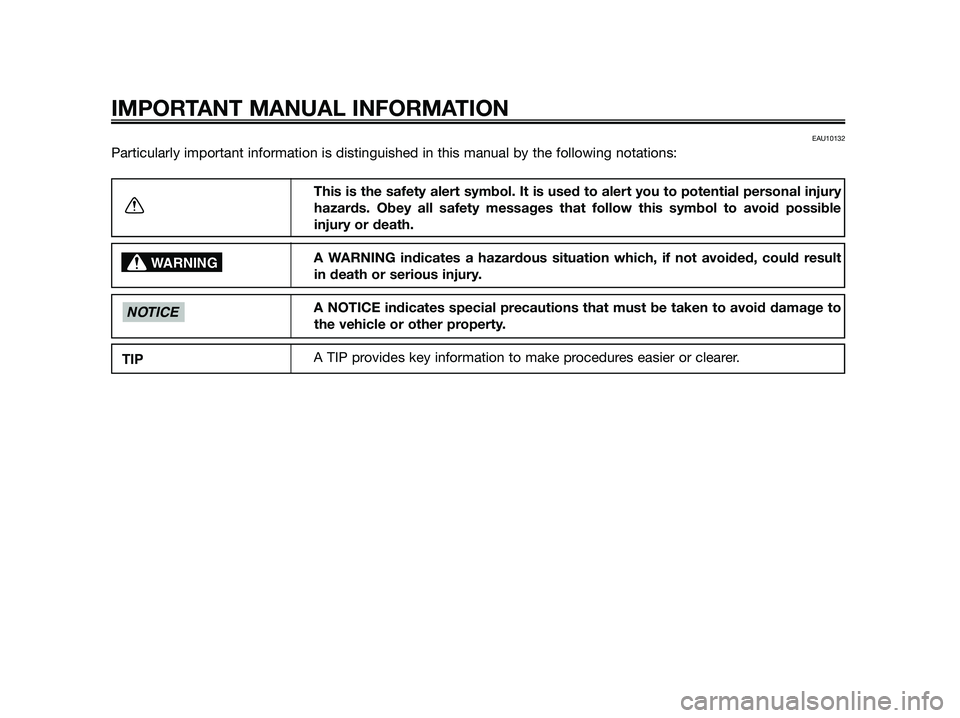
EAU10132
Particularly important information is distinguished in this manual by the following notations:
IMPORTANT MANUAL INFORMATION
This is the safety alert symbol. It is used to alert you to potential personal injury
hazards. Obey all safety messages that follow this symbol to avoid possible
injury or death.
A WARNING indicates a hazardous situation which, if not avoided, could result
in death or serious injury.
A NOTICE indicates special precautions that must be taken to avoid damage to
the vehicle or other property.
A TIP provides key information to make procedures easier or clearer.
TIP
NOTICE
WARNING
Page 6 of 76
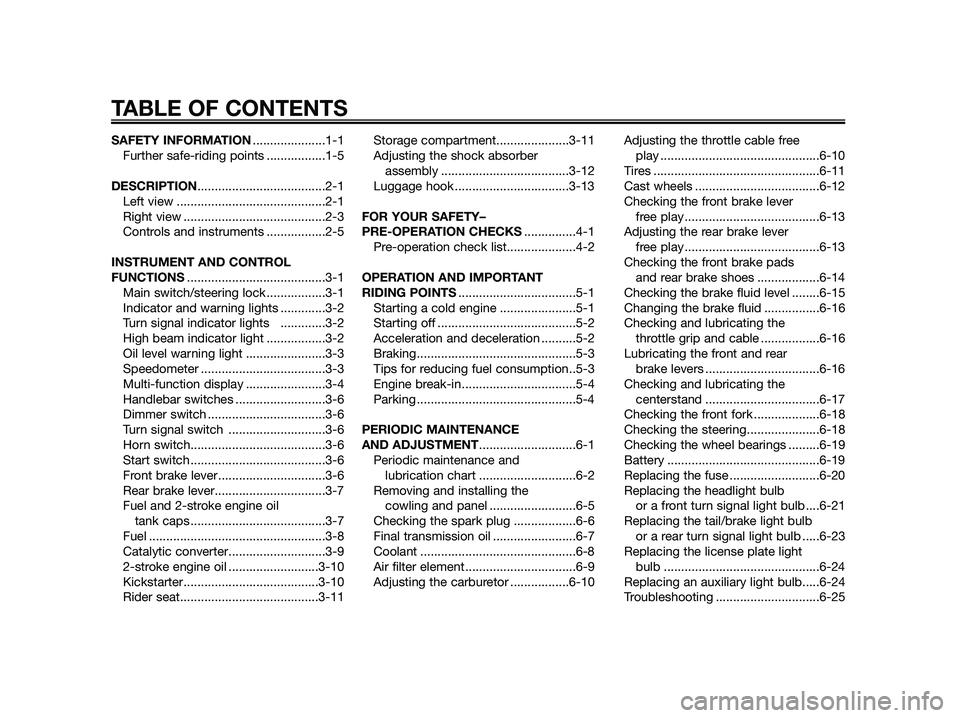
SAFETY INFORMATION.....................1-1
Further safe-riding points .................1-5
DESCRIPTION.....................................2-1
Left view ...........................................2-1
Right view .........................................2-3
Controls and instruments .................2-5
INSTRUMENT AND CONTROL
FUNCTIONS........................................3-1
Main switch/steering lock .................3-1
Indicator and warning lights .............3-2
Turn signal indicator lights .............3-2
High beam indicator light .................3-2
Oil level warning light .......................3-3
Speedometer ....................................3-3
Multi-function display .......................3-4
Handlebar switches ..........................3-6
Dimmer switch ..................................3-6
Turn signal switch ............................3-6
Horn switch.......................................3-6
Start switch .......................................3-6
Front brake lever...............................3-6
Rear brake lever................................3-7
Fuel and 2-stroke engine oil
tank caps .......................................3-7
Fuel ...................................................3-8
Catalytic converter............................3-9
2-stroke engine oil ..........................3-10
Kickstarter.......................................3-10
Rider seat........................................3-11Storage compartment.....................3-11
Adjusting the shock absorber
assembly .....................................3-12
Luggage hook .................................3-13
FOR YOUR SAFETY–
PRE-OPERATION CHECKS...............4-1
Pre-operation check list....................4-2
OPERATION AND IMPORTANT
RIDING POINTS..................................5-1
Starting a cold engine ......................5-1
Starting off ........................................5-2
Acceleration and deceleration ..........5-2
Braking..............................................5-3
Tips for reducing fuel consumption..5-3
Engine break-in.................................5-4
Parking ..............................................5-4
PERIODIC MAINTENANCE
AND ADJUSTMENT............................6-1
Periodic maintenance and
lubrication chart ............................6-2
Removing and installing the
cowling and panel .........................6-5
Checking the spark plug ..................6-6
Final transmission oil ........................6-7
Coolant .............................................6-8
Air filter element ................................6-9
Adjusting the carburetor .................6-10Adjusting the throttle cable free
play ..............................................6-10
Tires ................................................6-11
Cast wheels ....................................6-12
Checking the front brake lever
free play .......................................6-13
Adjusting the rear brake lever
free play .......................................6-13
Checking the front brake pads
and rear brake shoes ..................6-14
Checking the brake fluid level ........6-15
Changing the brake fluid ................6-16
Checking and lubricating the
throttle grip and cable .................6-16
Lubricating the front and rear
brake levers .................................6-16
Checking and lubricating the
centerstand .................................6-17
Checking the front fork ...................6-18
Checking the steering.....................6-18
Checking the wheel bearings .........6-19
Battery ............................................6-19
Replacing the fuse ..........................6-20
Replacing the headlight bulb
or a front turn signal light bulb ....6-21
Replacing the tail/brake light bulb
or a rear turn signal light bulb .....6-23
Replacing the license plate light
bulb .............................................6-24
Replacing an auxiliary light bulb.....6-24
Troubleshooting ..............................6-25
TABLE OF CONTENTS
Page 8 of 76
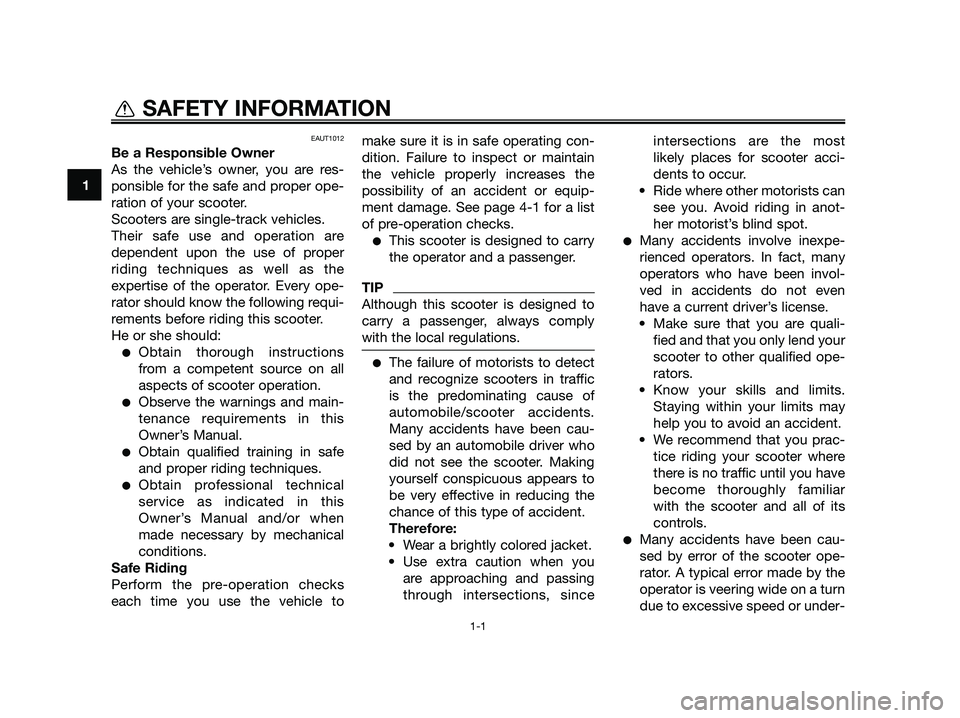
EAUT1012
Be a Responsible Owner
As the vehicle’s owner, you are res-
ponsible for the safe and proper ope-
ration of your scooter.
Scooters are single-track vehicles.
Their safe use and operation are
dependent upon the use of proper
riding techniques as well as the
expertise of the operator. Every ope-
rator should know the following requi-
rements before riding this scooter.
He or she should:
●Obtain thorough instructions
from a competent source on all
aspects of scooter operation.
●Observe the warnings and main-
tenance requirements in this
Owner’s Manual.
●Obtain qualified training in safe
and proper riding techniques.
●Obtain professional technical
service as indicated in this
Owner’s Manual and/or when
made necessary by mechanical
conditions.
Safe Riding
Perform the pre-operation checks
each time you use the vehicle tomake sure it is in safe operating con-
dition. Failure to inspect or maintain
the vehicle properly increases the
possibility of an accident or equip-
ment damage. See page 4-1 for a list
of pre-operation checks.
●This scooter is designed to carry
the operator and a passenger.
TIP
Although this scooter is designed to
carry a passenger, always comply
with the local regulations.
●The failure of motorists to detect
and recognize scooters in traffic
is the predominating cause of
automobile/scooter accidents.
Many accidents have been cau-
sed by an automobile driver who
did not see the scooter. Making
yourself conspicuous appears to
be very effective in reducing the
chance of this type of accident.
Therefore:
• Wear a brightly colored jacket.
• Use extra caution when you
are approaching and passing
through intersections, sinceintersections are the most
likely places for scooter acci-
dents to occur.
• Ride where other motorists can
see you. Avoid riding in anot-
her motorist’s blind spot.
●Many accidents involve inexpe-
rienced operators. In fact, many
operators who have been invol-
ved in accidents do not even
have a current driver’s license.
• Make sure that you are quali-
fied and that you only lend your
scooter to other qualified ope-
rators.
• Know your skills and limits.
Staying within your limits may
help you to avoid an accident.
• We recommend that you prac-
tice riding your scooter where
there is no traffic until you have
become thoroughly familiar
with the scooter and all of its
controls.
●Many accidents have been cau-
sed by error of the scooter ope-
rator. A typical error made by the
operator is veering wide on a turn
due to excessive speed or under-
1
SAFETY INFORMATION
1-1
Page 18 of 76

INSTRUMENT AND CONTROL FUNCTIONS
3-1
3
EAU10460
Main switch/steering lock
The main switch/steering lock con-
trols the ignition and lighting systems,
and is used to lock the steering. The
various positions are described
below.
EAU10640
“” ON
All electrical circuits are supplied with
power, and the engine can be started.
The key cannot be removed.
TIP
The headlight, meter lighting and tai-
llight come on automatically when the
engine is started.
EAU10661
“” OFF
All electrical systems are off. The key
can be removed.
EWA10061
sWARNING
Never turn the key to “ ” or “ ”
while the vehicle is moving. Other-
wise the electrical systems will be
switched off, which may result in
loss of control or an accident.
EAU10670
The 2-stroke engine oil level warning
light should come on. (See page 3-2).
EAU10681
“ ” LOCK
The steering is locked, and all electri-
cal systems are off. The key can be
removed.T
o lock the steering
1. Push.
2. Turn.
1. Turn the handlebars all the way to
the left.
2. Push the key in from the “ ”
position, and then turn it to “ ”
while still pushing it.
3. Remove the key.
Page 19 of 76

To unlock the steering
1. Push.
2. Turn.
1. Push the key in, and then turn it
to “ ” while still pushing it.
EAU11003
Indicator and warning lights
1. Left turn signal indicator light “ ”
2. Oil level warning light “ ”
3. High beam indicator light “ ”
4. Right turn signal indicator light “ ”1. Left turn signal indicator light “ ”
2. Coolant temperature warning light “ ”
3. Oil level warning light “ ”
4. High beam indicator light “ ”
5. Right turn signal indicator light “ ”
EAU11030
Turn signal indicator lights “ ”
and “ ”
The corresponding indicator light flas-
hes when the turn signal switch is
pushed to the left or right.
EAU11080
High beam indicator light “ ”
This indicator light comes on when
the high beam of the headlight is swit-
ched on.
km/h
01020304050607080
14
3 25
CS50Z
km/h
01020304050607080
143 2
CS50/CS50M1
2
INSTRUMENT AND CONTROL FUNCTIONS
3-2
3
Page 20 of 76

EAU11181
Oil level warning light “ ”
This warning light comes on when the
key is in the “ ” position or if the oil
level in the 2-stroke engine oil tank is
low during operation. If the warning
light comes on during operation, stop
immediately and fill the oil tank with
Yamalube 2 or equivalent 2-stroke
engine oil of either JASO grade “FC”
or ISO grades “EG-C” or “EG-D”. The
warning light should go off after the 2-
stroke engine oil tank has been refi-
lled.
TIP
If the warning light does not come on
when the key is in the “ ” position
or does not go off after the 2-stroke
engine oil tank has been refilled, have
a Yamaha dealer check the electrical
circuit.
ECA16291
NOTICE
Do not operate the vehicle until you
know that the engine oil level is suf-
ficient.
EAUS1530
Speedometer
1. Speedometer
1. Speedometer
1. Speedometer
1. Speedometer
The speedometer shows the riding
speed.
k m/hmph
0
10
203040
50
01020304050 6 0 7 0 8 0
1
CS50Z (for UK only)
k m/hmph
0
10
203040
50
01020304050 6 0 7 0 8 0
1
CS50/CS50M (for UK only)
k m/h
010
20
30405060
70
80
1
CS50Z
k m/h
010
20
30405060
70
80
1
CS50/CS50M
INSTRUMENT AND CONTROL FUNCTIONS
3-3
3
Page 21 of 76

EAUS1424
Multi-function display
1. Select button
2. Odometer/tripmeter
3. Clock
4. Fuel meter
EWA12312
sWARNING
Be sure to stop the vehicle before
making any setting changes to the
multi-function display. Changing
settings while riding can distract
the operator and increase the risk
of an accident.
The multi-function display is equip-
ped with the following:
●a digital clock
●an odometer (which shows the
total distance traveled)
●a tripmeter (which shows the dis-
tance traveled since it was last
set to zero)
●a fuel gauge
●a self-diagnosis device
●a function button (which selects,
sets and resets various modes of
the multi-function display)
TIP
●Be sure to turn the key to “ ”
before using the button.
●For the U.K. only: The odometer
and tripmeter are displayed in
miles.
To set the clock:
1. Select the odometer and push
the button for at least two
seconds.
2. When the hour digits start flas-
hing, push the button to set the
hours.3. To change the ten-minute digit,
push the button for at least two
seconds.
4. When the ten-minute digit starts
flashing, push the button to set it.
5. To change the one-minute digit,
push the button for at least two
seconds.
km/h
01020304050607080
1
43 2
INSTRUMENT AND CONTROL FUNCTIONS
3-4
3
Page 25 of 76
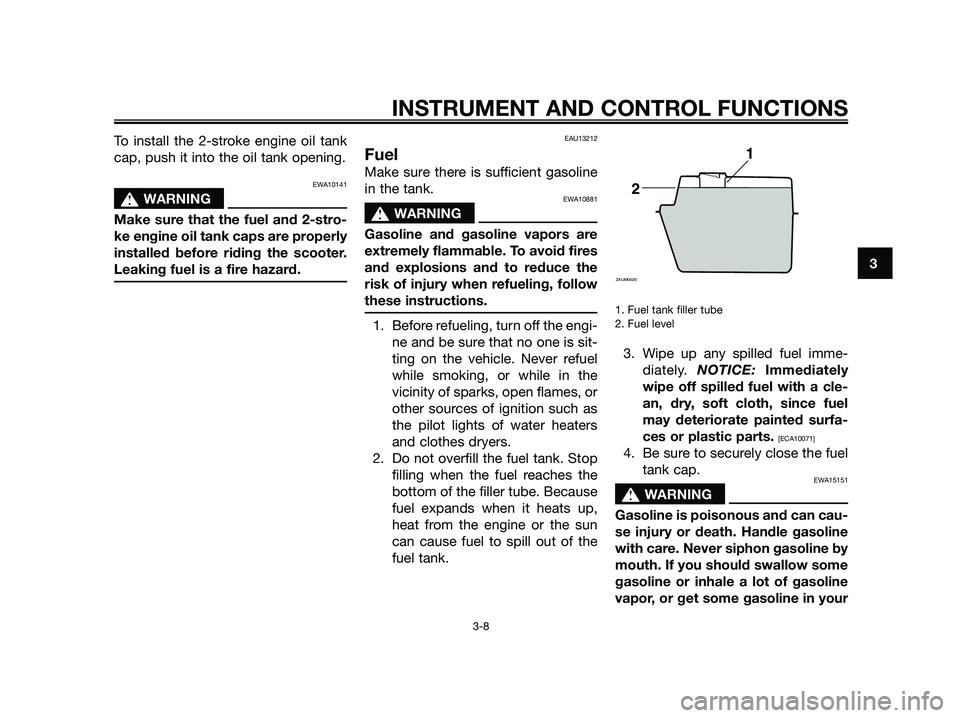
To install the 2-stroke engine oil tank
cap, push it into the oil tank opening.
EWA10141
sWARNING
Make sure that the fuel and 2-stro-
ke engine oil tank caps are properly
installed before riding the scooter.
Leaking fuel is a fire hazard.
EAU13212
Fuel
Make sure there is sufficient gasoline
in the tank.
EWA10881
sWARNING
Gasoline and gasoline vapors are
extremely flammable. To avoid fires
and explosions and to reduce the
risk of injury when refueling, follow
these instructions.
1. Before refueling, turn off the engi-
ne and be sure that no one is sit-
ting on the vehicle. Never refuel
while smoking, or while in the
vicinity of sparks, open flames, or
other sources of ignition such as
the pilot lights of water heaters
and clothes dryers.
2. Do not overfill the fuel tank. Stop
filling when the fuel reaches the
bottom of the filler tube. Because
fuel expands when it heats up,
heat from the engine or the sun
can cause fuel to spill out of the
fuel tank.
1. Fuel tank filler tube
2. Fuel level
3. Wipe up any spilled fuel imme-
diately. NOTICE: Immediately
wipe off spilled fuel with a cle-
an, dry, soft cloth, since fuel
may deteriorate painted surfa-
ces or plastic parts.
[ECA10071]
4. Be sure to securely close the fuel
tank cap.
EWA15151
sWARNING
Gasoline is poisonous and can cau-
se injury or death. Handle gasoline
with care. Never siphon gasoline by
mouth. If you should swallow some
gasoline or inhale a lot of gasoline
vapor, or get some gasoline in your
1
2
ZAUM0020
INSTRUMENT AND CONTROL FUNCTIONS
3-8
3
Page 26 of 76
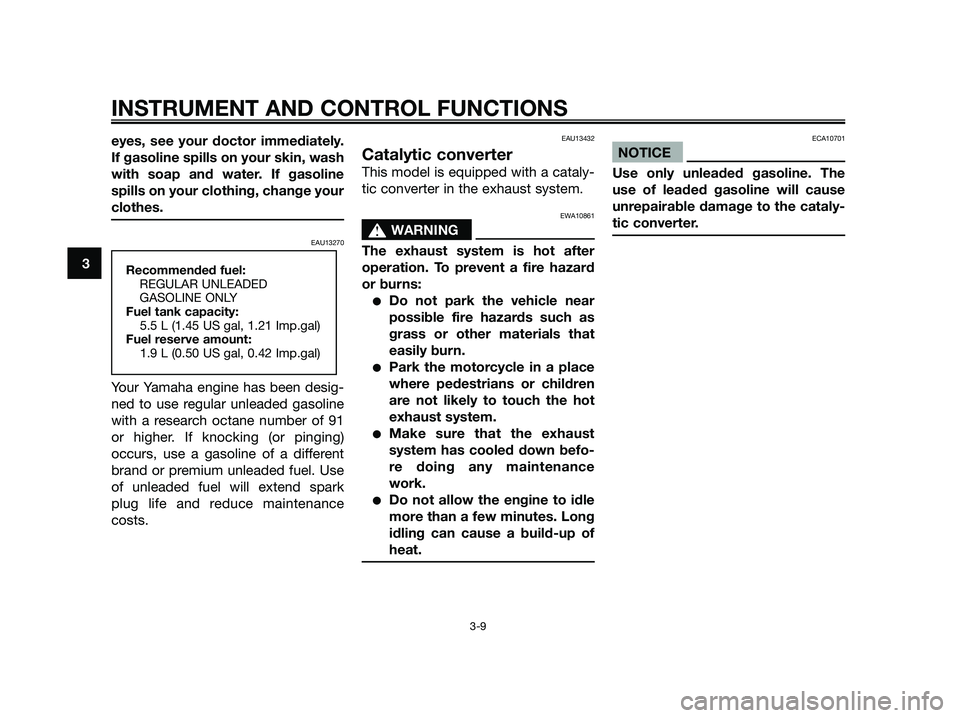
eyes, see your doctor immediately.
If gasoline spills on your skin, wash
with soap and water. If gasoline
spills on your clothing, change your
clothes.
EAU13270
Your Yamaha engine has been desig-
ned to use regular unleaded gasoline
with a research octane number of 91
or higher. If knocking (or pinging)
occurs, use a gasoline of a different
brand or premium unleaded fuel. Use
of unleaded fuel will extend spark
plug life and reduce maintenance
costs.
EAU13432
Catalytic converter
This model is equipped with a cataly-
tic converter in the exhaust system.
EWA10861
sWARNING
The exhaust system is hot after
operation. To prevent a fire hazard
or burns:
●Do not park the vehicle near
possible fire hazards such as
grass or other materials that
easily burn.
●Park the motorcycle in a place
where pedestrians or children
are not likely to touch the hot
exhaust system.
●Make sure that the exhaust
system has cooled down befo-
re doing any maintenance
work.
●Do not allow the engine to idle
more than a few minutes. Long
idling can cause a build-up of
heat.
ECA10701
NOTICE
Use only unleaded gasoline. The
use of leaded gasoline will cause
unrepairable damage to the cataly-
tic converter.
Recommended fuel:
REGULAR UNLEADED
GASOLINE ONLY
Fuel tank capacity:
5.5 L (1.45 US gal, 1.21 Imp.gal)
Fuel reserve amount:
1.9 L (0.50 US gal, 0.42 Imp.gal)
INSTRUMENT AND CONTROL FUNCTIONS
3-9
3